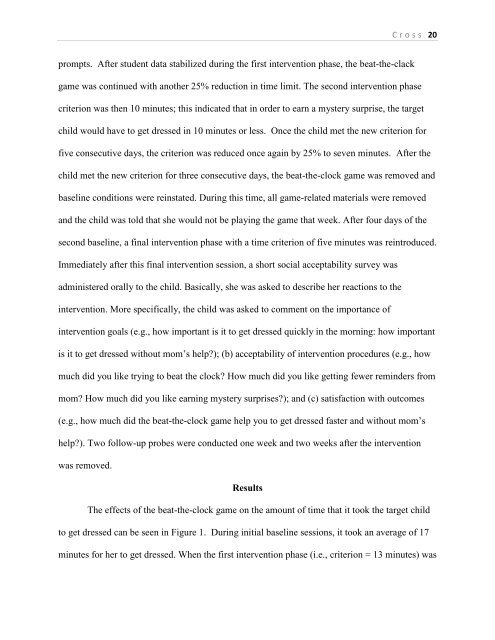THE EFFECTS OF A TIMER AND MYSTERY MOTIVATORS ON THE ...
THE EFFECTS OF A TIMER AND MYSTERY MOTIVATORS ON THE ...
THE EFFECTS OF A TIMER AND MYSTERY MOTIVATORS ON THE ...
You also want an ePaper? Increase the reach of your titles
YUMPU automatically turns print PDFs into web optimized ePapers that Google loves.
C r o s s 20<br />
prompts. After student data stabilized during the first intervention phase, the beat-the-clack<br />
game was continued with another 25% reduction in time limit. The second intervention phase<br />
criterion was then 10 minutes; this indicated that in order to earn a mystery surprise, the target<br />
child would have to get dressed in 10 minutes or less. Once the child met the new criterion for<br />
five consecutive days, the criterion was reduced once again by 25% to seven minutes. After the<br />
child met the new criterion for three consecutive days, the beat-the-clock game was removed and<br />
baseline conditions were reinstated. During this time, all game-related materials were removed<br />
and the child was told that she would not be playing the game that week. After four days of the<br />
second baseline, a final intervention phase with a time criterion of five minutes was reintroduced.<br />
Immediately after this final intervention session, a short social acceptability survey was<br />
administered orally to the child. Basically, she was asked to describe her reactions to the<br />
intervention. More specifically, the child was asked to comment on the importance of<br />
intervention goals (e.g., how important is it to get dressed quickly in the morning: how important<br />
is it to get dressed without mom’s help?); (b) acceptability of intervention procedures (e.g., how<br />
much did you like trying to beat the clock? How much did you like getting fewer reminders from<br />
mom? How much did you like earning mystery surprises?); and (c) satisfaction with outcomes<br />
(e.g., how much did the beat-the-clock game help you to get dressed faster and without mom’s<br />
help?). Two follow-up probes were conducted one week and two weeks after the intervention<br />
was removed.<br />
Results<br />
The effects of the beat-the-clock game on the amount of time that it took the target child<br />
to get dressed can be seen in Figure 1. During initial baseline sessions, it took an average of 17<br />
minutes for her to get dressed. When the first intervention phase (i.e., criterion = 13 minutes) was
















